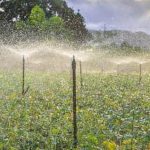Planting time for vegetable gardens is crucial for the overall success and productivity of a garden. The timing of when to plant your vegetables can have a significant impact on their health, growth, and yield. In this article, we will explore the importance of planting time and how it affects the overall health and productivity of your vegetable garden.
One of the key factors to consider when determining the planting time for your vegetable garden is the local climate. Understanding the first and last frost dates for your specific area is essential in order to choose the right time to plant. Factors such as temperature, humidity, and precipitation should be taken into account when planning your planting schedule.
In addition to climate considerations, soil preparation also plays a vital role in successful vegetable gardening. We will discuss tips for preparing the soil before planting and emphasize the importance of soil quality in ensuring healthy plant growth. By focusing on these fundamental aspects, gardeners can set themselves up for a bountiful harvest that lasts throughout the growing season.
Climate Considerations
When it comes to determining the planting time for your vegetable garden, one of the most important factors to consider is the local climate. The specific climate of your area will heavily influence the success of your garden, so it’s crucial to understand the unique conditions that are present. Factors such as temperature, precipitation, and sunlight can all impact when it’s best to plant certain vegetables.
To determine the ideal planting time based on the climate, you’ll need to understand the first and last frost dates for your specific area. Knowing these dates will help you plan when to start planting in the spring and when to wrap up in the fall. This information is readily available through local gardening resources or agricultural extension offices, and it provides valuable insight into how your local climate affects growing seasons.
In addition to frost dates, pay attention to other climate patterns that may affect your vegetable garden. Consider factors such as humidity levels and typical weather patterns throughout the growing season. By taking these climate considerations into account, you can make informed decisions about when to plant different types of vegetables in order to optimize their growth and productivity.
- Consider first and last frost dates
- Understand other climate patterns (humidity levels, weather patterns)
- Use local gardening resources or agricultural extension offices for information
Soil Preparation
Before planting vegetables in your garden, it is crucial to prepare the soil properly. The quality of the soil directly impacts the health and productivity of your vegetable garden. Here are some important tips for soil preparation:
1. Test the soil: Start by testing the pH level of the soil to determine its acidity or alkalinity. Most vegetables prefer a slightly acidic soil with a pH level of 6 to 7. You can purchase a DIY soil testing kit or send a sample to a local agricultural extension office for analysis.
2. Amend the soil: Based on the results of your soil test, you may need to amend the soil with organic matter such as compost, manure, or peat moss. These organic materials help improve soil structure, retain moisture, and provide essential nutrients for healthy plant growth.
3. Remove weeds and debris: Clear any weeds, rocks, or other debris from the planting area. Weeds compete with vegetables for water and nutrients, while rocks and debris can hinder healthy root development.
4. Till the soil: Use a garden tiller or hand tools to loosen the soil and incorporate any amendments thoroughly. Properly tilled soil allows roots to penetrate easily and promotes good drainage.
By following these steps for preparing your garden’s soil before planting time for vegetable gardens arrives, you’ll set the stage for a successful growing season while ensuring that your vegetables have everything they need to thrive in their environment. Remember that healthy plants start with healthy soil.
Choosing the Right Vegetables
When it comes to vegetable gardening, choosing the right vegetables to plant at the appropriate time is crucial for a successful harvest. Different vegetables have specific growing requirements and thrive in certain seasons. Understanding the difference between cool-season and warm-season vegetables is essential when determining which crops to plant at specific times of the year.
Cool-season vegetables, such as lettuce, spinach, and carrots, are best suited for planting in early spring or late summer through fall. These types of vegetables can tolerate cooler temperatures and even benefit from a light frost. On the other hand, warm-season vegetables like tomatoes, peppers, and squash require higher temperatures to grow successfully and should be planted in late spring or early summer.
It’s important to consider the local climate when selecting which vegetables to plant. Knowing the average first and last frost dates for your area will help determine the optimal planting time for both cool-season and warm-season crops. This information can be obtained from local agricultural extension offices or garden centers.
In addition to understanding the seasonal preferences of different vegetables, it’s also essential to consider factors such as sunlight exposure, soil type, and water requirements. By carefully choosing the right vegetables for each season based on these considerations, gardeners can maximize their harvest while promoting healthy plant growth.
| Cool-Season Vegetables | Warm-Season Vegetables |
|---|---|
| Lettuce | Tomatoes |
| Spinach | Peppers |
| Carrots | Squash |
Planting Schedule
When it comes to a successful vegetable garden, timing is essential. Knowing the ideal planting time for vegetable gardens can greatly impact the productivity and health of your plants. The right timing ensures that the vegetables have the best conditions for growth, resulting in a bountiful harvest. In this section, we will provide a detailed guide on when to plant specific types of vegetables and strategies for staggered planting to extend the harvest season.
Different vegetables have different optimal planting times based on whether they are cool-season or warm-season crops. Cool-season vegetables, such as lettuce, spinach, and peas, thrive in cooler temperatures and should be planted in early spring or late summer for a fall harvest. On the other hand, warm-season vegetables like tomatoes, peppers, and cucumbers require warmer temperatures to grow successfully and should be planted after the last frost date in spring.
Staggered planting is a technique used to ensure a continuous supply of fresh produce throughout the growing season. By planting small batches of seeds or transplants at regular intervals, you can avoid an overwhelming abundance of certain vegetables all at once. This method also helps maximize space in the garden and minimizes potential waste by spreading out the harvest over time.
| Vegtable | Planting Time |
|---|---|
| Lettuce | Early Spring or Late Summer |
| Tomatoes | After Last Frost Date in Spring |
| Carrots | Cool-Season: Early Spring Warm-Season: Late Summer |
By following this schedule and considering staggered planting, you can optimize your vegetable garden for a successful and abundant harvest.
Seed Starting vs Transplants
When it comes to planting time for vegetable gardens, one important decision to make is whether to start your vegetables from seeds or use transplants. Both methods have their own set of advantages and disadvantages, and understanding the differences between them can help you make the best choice for your garden.
Pros and Cons of Starting From Seeds
Starting vegetables from seeds offers a wide variety of options, allowing you to choose from a broader selection of vegetable varieties. Additionally, starting from seeds can be more cost-effective than purchasing transplants. However, this method requires more time and attention as you will need to provide the right conditions for germination and early growth. It also means that you will need to be patient as some vegetables take longer to mature when started from seeds.
Pros and Cons of Using Transplants
Using transplants can be a convenient option for those who want to skip the early stages of plant growth. This method allows you to bypass the germination phase, providing a head start on the growing season.
Transplants are especially beneficial for vegetables with long growing seasons or those that require specific temperature conditions that may not be achievable in certain regions. However, purchasing transplants can be more expensive than starting from seeds, and there may be limitations on the variety of plants available.
Ultimately, the decision between seed starting and using transplants depends on your specific gardening goals, available resources, and personal preferences. Some gardeners may choose to utilize both methods depending on the type of vegetable they intend to grow. By considering these factors, you can determine which approach is best suited for your vegetable garden while maximizing its productivity and health throughout the planting time for vegetable gardens.
Care and Maintenance
Once you have planted your vegetable garden, it is essential to provide proper care and maintenance to ensure a successful harvest. This section will cover important tips for maintaining your garden after planting, including watering, fertilizing, and pest control strategies for different stages of growth.
Regular Watering Schedule
One of the most critical aspects of caring for a vegetable garden is ensuring that it receives an adequate amount of water. Different vegetables have varying water requirements, so it is essential to research the specific needs of the plants in your garden. In general, vegetables should be watered deeply but infrequently to encourage strong root development.
Monitoring Soil Moisture
To determine when to water your vegetable garden, monitor the soil moisture regularly. Stick your finger into the soil – if it feels dry about an inch below the surface, it’s time to water. Additionally, consider investing in a moisture meter to accurately gauge the moisture levels in different areas of your garden.
Organic Fertilizers
Using organic fertilizers can contribute to healthier soil and better nutrient absorption by plants. Consider incorporating compost or organic fertilizer into your soil before planting and supplementing with additional fertilizer as needed throughout the growing season.
Natural Pest Control Methods
Implementing natural pest control methods such as companion planting, attracting beneficial insects, and using physical barriers can help manage pests without resorting to chemical pesticides. Regularly inspect your plants for signs of pest damage and take appropriate action as necessary.
By following these care and maintenance tips, you can help ensure a bountiful harvest from your vegetable garden. Taking proactive measures to keep your plants healthy and thriving will ultimately lead to a more productive garden come harvesting time.
Conclusion
In conclusion, the timing of planting for vegetable gardens is a crucial factor that greatly impacts the overall productivity and health of the garden. The success of a vegetable garden depends on careful planning and consideration of factors such as local climate, soil quality, and choosing the right vegetables to plant at specific times of the year.
By understanding the first and last frost dates for a particular area, gardeners can determine the optimal planting time and avoid potential damage to their crops. Additionally, proper soil preparation and maintenance play key roles in ensuring successful vegetable gardening. This includes knowing which vegetables are suitable for planting during different seasons, and implementing strategies for staggered planting to extend the harvest season.
As gardeners plan their planting time for vegetable gardens, it’s important to remember that care and maintenance continue to be essential after planting. Watering, fertilizing, and pest control strategies should be tailored to different stages of growth in order to support healthy and bountiful yields. By carefully considering all these factors throughout the growing season, amateur and experienced gardeners alike can look forward to a successful harvest from their vegetable gardens.

If you’re looking to get into vegetable gardening, or are just looking for some tips on how to make your current garden better, then you’ve come to the right place! My name is Ethel and I have been gardening for years. In this blog, I’m going to share with you some of my best tips on how to create a successful vegetable garden.





